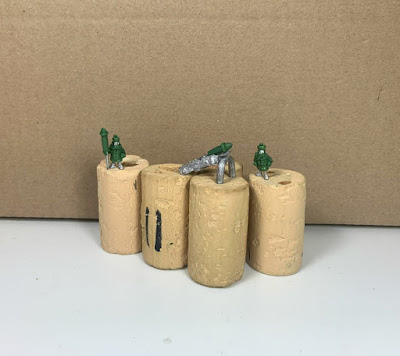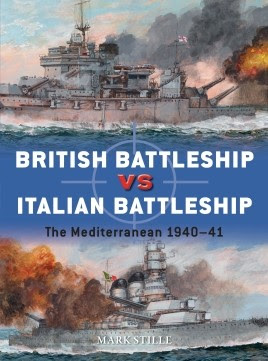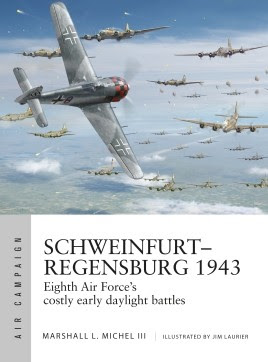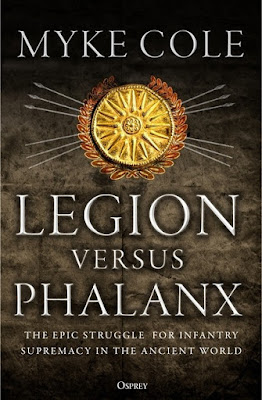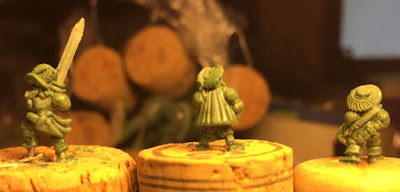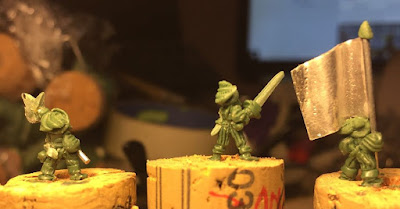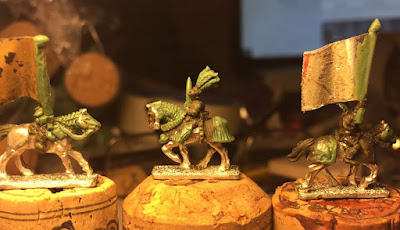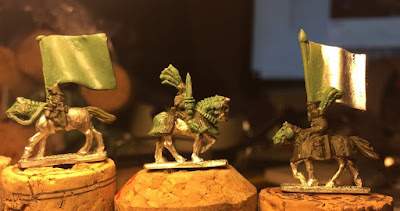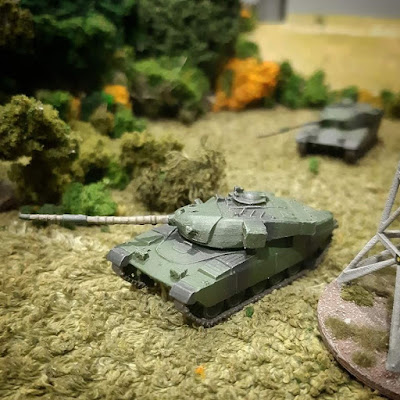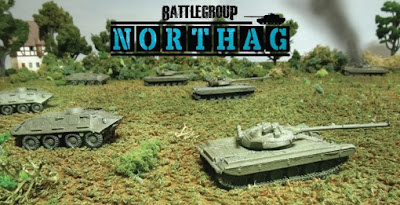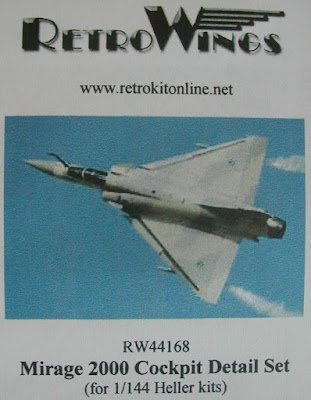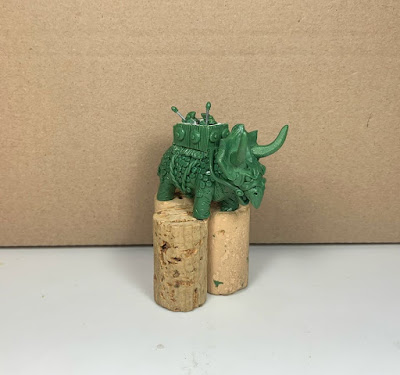31 Jan 2020
Project Update #6: 10mm Vampire Vikings, Kickstarter from Cromarty Forge
5th Stretch goal unlocked
Thanks to recent (large) pledges the Werewolves are now unlocked. This pair of lead free pewter werewolf models (and a second pair mirrored from the original sculpts) will be added to the Gods of the dead pack. They look particularly nice flanking Angrboda as protective children, or could be added to a dire wolf pack to denote the command stand.
Angrboda's children
I have also added two new pledge levels, (clearly I was not thinking big enough when I started this kickstarter :-). On the highest pledge level I will include 2 cottages (see image below). I hope to be able to include these (and some other buildings) in the main campaign, but I am waiting to see how the casts come out. However if you pledge at the "Insanity?" level, I'll either send you casts (if they are good) or 3D prints (if not).
Cottage Farm (Huscarls for scale)
Thanks for your support
JB
Kickstarter
Cromarty Forge
Price Increase from Pendraken Miniatures
Don't forget that our price increase will be happening at midnight on Saturday, so you've still got time to place your orders at the current prices!
The regular 30 foot / 15 cavalry packs will be going from £5.25 to £5.50. There won't be any price changes to our vehicles, WWII-onwards artillery packs, or our flag sheets.
There will also be a small increase on the Vallejo paints, from £2.30 --> £2.35 per 18ml pot.
Pendraken Miniatures
Quick Update from Traders Galaxy
Ok Friday lunchtime and time for a quick update. What a busy week!
It went so fast as i was away in Sydney for a day.
As someone that predominantly masterminds most of this alone, i still want to give thanks to my artists and sculptor for all their great work. Likewise my mod team who keep me sane and grounded. A top bunch of blokes.
Ok so where are we at?
My goal over the next couple of months is to finalise and lock in all stat cards for 2020.
Once locked in, they will be ready to print.
There is a lot of stuff, and i mean a lot of things in the development pipeline. Dare i say more than ever before.
I am thinking of something a little different for February. Potentially offering some limited edition prints of the recent Bot War artwork as a prize draw for anyone spending $150 or more in February. I would draw on Facebook live at the end of the month.
I am unsure if this would appeal. It would be the Valiants vs Deceivers art and the Infesters vs Atlanticans art.
Also, please see below a work in progress concept of the new Kamen.
Kamen
Traders Galaxy
It went so fast as i was away in Sydney for a day.
As someone that predominantly masterminds most of this alone, i still want to give thanks to my artists and sculptor for all their great work. Likewise my mod team who keep me sane and grounded. A top bunch of blokes.
Ok so where are we at?
My goal over the next couple of months is to finalise and lock in all stat cards for 2020.
Once locked in, they will be ready to print.
There is a lot of stuff, and i mean a lot of things in the development pipeline. Dare i say more than ever before.
I am thinking of something a little different for February. Potentially offering some limited edition prints of the recent Bot War artwork as a prize draw for anyone spending $150 or more in February. I would draw on Facebook live at the end of the month.
I am unsure if this would appeal. It would be the Valiants vs Deceivers art and the Infesters vs Atlanticans art.
Also, please see below a work in progress concept of the new Kamen.
Kamen
Traders Galaxy
30 Jan 2020
Project Update #5: 10mm Vampire Vikings, Kickstarter from Cromarty Forge
Stretch Goal 4 Unlocked
Thanks to all backers I am now able to unlock the Battle cats, these will be added to the Gods of the Dead Pack. Below is a round up of the elements that have been added to the Gods of the dead so far:
Gods of the Dead, Original Content
Dark Guards: Unlocked
Dark Bards: Unlocked
Dark Banners: Unlocked
Battle Cats: Unlocked
Thanks again for your support.
JB
Kickstarter
Cromarty Forge
New Releases for January 2020 from Osprey Publishing Ltd
New Releases for January 2020, we have another fantastic set of new releases.
Order Today
Audacious Missions of World War II
Winning World War II was about more than military force. It required guile, and tremendous acts of bravery by Special Forces and intelligence operatives who had the odds stacked against them. Using hundreds of documents and images from The National Archives, including some that have never been seen in print before, this book reveals some of World War II's most audacious missions.
These include Operation Anthropoid, the plot to assassinate SS General Reinhard Heydrich in Czechoslovakia in 1942, Operation Chariot, the attempt to damage the mighty German warship Tirpitz while she was in dock in St-Nazaire in France; and Operation Mincemeat, a complex plot whereby a corpse, replete with documentation designed to mislead the enemy, was dropped in southern Spain to spread misinformation.
The Spatha
Adopted from the Celts in the 1st century BC, the spatha, a lethal and formidable chopping blade, became the primary sword of the Roman soldier in the Later Empire. Over the following centuries, the blade, its scabbard, and its system of carriage underwent a series of developments, until by the 3rd century AD it was the universal sidearm of both infantry and cavalry.
Thanks to its long reach, the spatha was the ideal cavalry weapon, replacing the long gladius hispaniensis in the later Republican period. As the manner in which Roman infantrymen fought evolved, styles of hand-to-hand combat changed so much that the gladius was superseded by the longer spatha during the 2nd century AD. Like the gladius, the spatha was technologically advanced, with a carefully controlled use of steel. Easy maintenance was key to its success and the spatha was designed to be easily repaired in the field where access to a forge may have been limited. It remained the main Roman sword into the Late Roman period and its influence survived into the Dark Ages with Byzantine, Carolingian and Viking blades.
Drawing together historical accounts, excavated artefacts and the results of the latest scientific analyses of the blades, renowned authority M.C. Bishop reveals the full history of the development, technology, training and use of the spatha: the sword that defended an empire.
Roman Standards & Standard-Bearers (2)
The Late Roman Empire was a period of significant change in the designs of standards and in the costumes of standard-bearers. During the middle decades of the chaotic 3rd century, evidence confirms the continued use of the old legionary eagle and the signa of the old cohorts and centuries, alongside flags and Imperial images. The two major trends over the later generations were the adoption of Christian symbols on standards (e.g. Constantine the Great's Chi-Rho), and the proliferation of different types of flags. This had begun in the late 2nd century with the adoption of the 'barbarian' dragon standard, the windsock-shaped draco, which continued to be displayed alongside various other flags in the Greek-speaking Eastern Empire, whose influence increased greatly. Meanwhile, the growing employment of foreign units was such that by the 5th century we have evidence of the use of Hunnic symbolism among a Roman general's suite of standards. The costumes of standard-bearers also evolved as 'Persian' styles spread from Constantinople.
This title explores all these changes in depth, charting the development of various costumes and designs and the waxing and waning influence of various cultures and religious considerations. The text is supported by specially commissioned illustrations and artist's reconstructions of the standards and their bearers.
British Battleship vs Italian Battleship
During World War II's battle for control of the Mediterranean, both the British and Italian navies planned to bring their battle fleets into play. At the centre of both of these fleets was a core of battleships which both sides expected to play a decisive role in the conflict.
On 9 July 1940, the two navies met in the central Mediterranean, as two Italian battleships faced off against three of their British counterparts. Christened the Battle of Calabria, the action allowed the ships to play to their strengths, engaging in a long-range gunnery duel, the very thing they had been designed for. Though both sides shot well, the only hit was scored by Warspite on the Italian battleship Giulio Cesare. The Italians were forced to withdraw, and the action ended up being indecisive, but it was the largest fleet action fought in the Mediterranean during the war. As well as this battle, there were other occasions during the war when both British and Italian battleships were present and influential, but during which they never engaged each other directly - the Battle of Spartivento on 27 November 1940, and the Battle of Cape Matapan on 28-29 March 1941.
Packed with full-colour artwork, carefully selected archive photographs and expert analysis, this title explores in detail the role played by British and Italian battleships in these encounters, and their influence in the Mediterranean theatre of World War II.
Ia Drang 1965
The Pleiku campaign of October-November 1965 was a major event in the Vietnam War, and it is usually regarded as the first substantial battle between the US Army and the People's Army of Vietnam. The brigade-sized actions involving elements of the US 1st Cavalry Division at Landing Zones X-Ray and Albany in the valley of the river Drang have become iconic episodes in the military history of the United States.
In 1965, in an effort to stem the Communist tide, the Americans began to commit substantial conventional ground forces to the war in Vietnam. Amongst these was the 1st Cavalry Division (Airmobile), a new type of formation equipped with a large fleet of helicopters. On 19 October, North Vietnamese forces besieged a Special Forces camp at Plei Me, and after the base was relieved days later, the commander of the 1st Cavalry Division, General Harry Kinnard, advocated using his troops to pursue the retreating Communist forces.
A substantial North Vietnamese concentration was discovered, but rather than the badly battered troops the US expected, these were relatively fresh troops that had recently arrived in the Central Highlands. On the morning of 14 November 1965, 1st Battalion, 7th Cavalry, commanded by Lt. Col. Hal Moore, landed at LZ X-Ray to start the first major set-piece battle of the Vietnam War. This title explores the events of the campaign that followed, using detailed maps, specially-commissioned bird's-eye views, and full-colour battle scenes to bring the narrative to life.
The History of the Panzerwaffe
The Germans transformed armoured warfare from a lumbering and ponderous experiment in World War I into something that could decide the outcome of conflicts. This technical and operational history is the definitive guide to the legendary Panzerwaffe, from its very infancy to the days when it made Europe its garden path at the height of Nazi German power. With rare and revealing combat reports, along with photographs sourced from previously unseen private and archival collections, it uncovers the technical and operational stories of the formidable armoured beasts that formed the backbone of the German war machine - tanks such as the Panzer I, II and 38(t).
Schweinfurt–Regensburg 1943
In 1943, the USAAF and RAF launched the Combined Bomber Offensive, designed to systematically destroy the industries that the German war machine relied on. At the top of the hit list were aircraft factories and plants making ball-bearings - a component thought to be a critical vulnerability. Schweinfurt in southern Germany was home to much of the ball-bearing industry and, together with the Messerschmitt factory in Regensburg, which built Bf 109 fighters, it was targeted in a huge and innovative strike.
Precision required that the targets were hit in daylight, but the raid was beyond the range of any existing escort fighter, so the B-17s would go in unprotected. The solution was to hit the two targets in a coordinated 'double-strike', with the Regensburg strike hitting first, drawing off the defending Luftwaffe fighters, and leaving the way clear for the Schweinfurt bombers. The Regensburg force would carry on over the Alps to North Africa, the first example of US 'shuttle bombing'.
Although the attack on Regensburg was successful, the damage to Schweinfurt only temporarily stalled production, and the Eighth Air Force had suffered heavy losses. It would take a sustained campaign, not just a single raid, to cripple the Schweinfurt works. However, when a follow-up raid was finally launched two months later, the losses sustained were even greater. This title explains how the USAAF launched its daylight bombing campaign in 1943, the technology and tactics available for the Schweinfurt-Regensburg missions, and how these costly failures forced a change of tack.
British Battle Tanks
When British soldiers charged across the Somme in September 1916 they were accompanied by a new and astonishing weapon - the tank. After a stuttering start armoured behemoths such as the Mark IV, Mark V and Whippet played a crucial role in bringing World War I to an end.
Marking the centenary of their battlefield debut, this comprehensive volume traces the design and development of the famous British invention during World War I and the increasingly tense years of the 1920s and 30s, from the first crude but revolutionary prototype to the ever-more sophisticated designs of later years. Bolstered by historic photographs and stunning illustrations, author David Fletcher brings us the thrilling history behind the early British battle tanks.
The Battleship USS Iowa
USS Iowa (BB-61) was the lead ship in one of the most famous classes of battleships ever commissioned into the US Navy. Transferred to the Pacific Fleet in 1944, the Iowa first fired her guns in anger in the Marshall Islands campaign, and sunk her first enemy ship, the Katori. The Iowa went on to serve across a number of pivotal Pacific War campaigns, including at the battles of the Philippine Sea and Leyte Gulf. The ship ended the war spending several months bombarding the Japanese Home Islands before the surrender in August 1945.
After taking part in the Korea War, the Iowa was decommissioned in 1958, before being briefly reactivated in the 1980s as part of President Reagan's 600-Ship Navy Plan. After being decommissioned a second and final time in 1990, the Iowa is now a museum ship in Los Angeles.
This new addition to the Anatomy of the Ship series is illustrated with contemporary photographs, scaled plans of the ship and hundreds of superb 3D illustrations which bring every detail of this historic battleship to life.
Legion versus Phalanx
From the time of Ancient Sumeria, the heavy infantry phalanx dominated the battlefield. Armed with spears or pikes, standing shoulder to shoulder with shields interlocking, the men of the phalanx presented an impenetrable wall of wood and metal to the enemy. Until, that is, the Roman legion emerged to challenge them as masters of infantry battle.
Covering the period in which the legion and phalanx clashed (280-168 BC), Myke Cole delves into their tactics, arms and equipment, organization and deployment. Drawing on original primary sources to examine six battles in which the legion fought the phalanx - Heraclea (280 BC), Asculum (279 BC), Beneventum (275 BC), Cynoscephalae (197 BC), Magnesia (190 BC), and Pydna (168 BC) - he shows how and why the Roman legion, with its flexible organization, versatile tactics and iron discipline, came to eclipse the hitherto untouchable Hellenistic phalanx and dominate the ancient battlefield.
Zona Alfa
Zona Alfa is a set of simple, fast-play skirmish rules for scavenging, exploring, and surviving in a near-future, post-apocalyptic Eastern European setting. Players take on the role of bandits, mercenaries, and military units fighting over the blasted Exclusion Zone and its abandoned artefacts. Customise your fighters with a variety of weapons and specialisms to create your ideal warband. With extended rules for campaigns, character progression, terrain, and environmental hazards, Zona Alfa contains all the tools required to engage in blistering firefights within the Exclusion Zone.
Osprey Publishing Ltd
Order Today
Audacious Missions of World War II
Winning World War II was about more than military force. It required guile, and tremendous acts of bravery by Special Forces and intelligence operatives who had the odds stacked against them. Using hundreds of documents and images from The National Archives, including some that have never been seen in print before, this book reveals some of World War II's most audacious missions.
These include Operation Anthropoid, the plot to assassinate SS General Reinhard Heydrich in Czechoslovakia in 1942, Operation Chariot, the attempt to damage the mighty German warship Tirpitz while she was in dock in St-Nazaire in France; and Operation Mincemeat, a complex plot whereby a corpse, replete with documentation designed to mislead the enemy, was dropped in southern Spain to spread misinformation.
The Spatha
Adopted from the Celts in the 1st century BC, the spatha, a lethal and formidable chopping blade, became the primary sword of the Roman soldier in the Later Empire. Over the following centuries, the blade, its scabbard, and its system of carriage underwent a series of developments, until by the 3rd century AD it was the universal sidearm of both infantry and cavalry.
Thanks to its long reach, the spatha was the ideal cavalry weapon, replacing the long gladius hispaniensis in the later Republican period. As the manner in which Roman infantrymen fought evolved, styles of hand-to-hand combat changed so much that the gladius was superseded by the longer spatha during the 2nd century AD. Like the gladius, the spatha was technologically advanced, with a carefully controlled use of steel. Easy maintenance was key to its success and the spatha was designed to be easily repaired in the field where access to a forge may have been limited. It remained the main Roman sword into the Late Roman period and its influence survived into the Dark Ages with Byzantine, Carolingian and Viking blades.
Drawing together historical accounts, excavated artefacts and the results of the latest scientific analyses of the blades, renowned authority M.C. Bishop reveals the full history of the development, technology, training and use of the spatha: the sword that defended an empire.
Roman Standards & Standard-Bearers (2)
The Late Roman Empire was a period of significant change in the designs of standards and in the costumes of standard-bearers. During the middle decades of the chaotic 3rd century, evidence confirms the continued use of the old legionary eagle and the signa of the old cohorts and centuries, alongside flags and Imperial images. The two major trends over the later generations were the adoption of Christian symbols on standards (e.g. Constantine the Great's Chi-Rho), and the proliferation of different types of flags. This had begun in the late 2nd century with the adoption of the 'barbarian' dragon standard, the windsock-shaped draco, which continued to be displayed alongside various other flags in the Greek-speaking Eastern Empire, whose influence increased greatly. Meanwhile, the growing employment of foreign units was such that by the 5th century we have evidence of the use of Hunnic symbolism among a Roman general's suite of standards. The costumes of standard-bearers also evolved as 'Persian' styles spread from Constantinople.
This title explores all these changes in depth, charting the development of various costumes and designs and the waxing and waning influence of various cultures and religious considerations. The text is supported by specially commissioned illustrations and artist's reconstructions of the standards and their bearers.
British Battleship vs Italian Battleship
During World War II's battle for control of the Mediterranean, both the British and Italian navies planned to bring their battle fleets into play. At the centre of both of these fleets was a core of battleships which both sides expected to play a decisive role in the conflict.
On 9 July 1940, the two navies met in the central Mediterranean, as two Italian battleships faced off against three of their British counterparts. Christened the Battle of Calabria, the action allowed the ships to play to their strengths, engaging in a long-range gunnery duel, the very thing they had been designed for. Though both sides shot well, the only hit was scored by Warspite on the Italian battleship Giulio Cesare. The Italians were forced to withdraw, and the action ended up being indecisive, but it was the largest fleet action fought in the Mediterranean during the war. As well as this battle, there were other occasions during the war when both British and Italian battleships were present and influential, but during which they never engaged each other directly - the Battle of Spartivento on 27 November 1940, and the Battle of Cape Matapan on 28-29 March 1941.
Packed with full-colour artwork, carefully selected archive photographs and expert analysis, this title explores in detail the role played by British and Italian battleships in these encounters, and their influence in the Mediterranean theatre of World War II.
Ia Drang 1965
The Pleiku campaign of October-November 1965 was a major event in the Vietnam War, and it is usually regarded as the first substantial battle between the US Army and the People's Army of Vietnam. The brigade-sized actions involving elements of the US 1st Cavalry Division at Landing Zones X-Ray and Albany in the valley of the river Drang have become iconic episodes in the military history of the United States.
In 1965, in an effort to stem the Communist tide, the Americans began to commit substantial conventional ground forces to the war in Vietnam. Amongst these was the 1st Cavalry Division (Airmobile), a new type of formation equipped with a large fleet of helicopters. On 19 October, North Vietnamese forces besieged a Special Forces camp at Plei Me, and after the base was relieved days later, the commander of the 1st Cavalry Division, General Harry Kinnard, advocated using his troops to pursue the retreating Communist forces.
A substantial North Vietnamese concentration was discovered, but rather than the badly battered troops the US expected, these were relatively fresh troops that had recently arrived in the Central Highlands. On the morning of 14 November 1965, 1st Battalion, 7th Cavalry, commanded by Lt. Col. Hal Moore, landed at LZ X-Ray to start the first major set-piece battle of the Vietnam War. This title explores the events of the campaign that followed, using detailed maps, specially-commissioned bird's-eye views, and full-colour battle scenes to bring the narrative to life.
The History of the Panzerwaffe
The Germans transformed armoured warfare from a lumbering and ponderous experiment in World War I into something that could decide the outcome of conflicts. This technical and operational history is the definitive guide to the legendary Panzerwaffe, from its very infancy to the days when it made Europe its garden path at the height of Nazi German power. With rare and revealing combat reports, along with photographs sourced from previously unseen private and archival collections, it uncovers the technical and operational stories of the formidable armoured beasts that formed the backbone of the German war machine - tanks such as the Panzer I, II and 38(t).
Schweinfurt–Regensburg 1943
In 1943, the USAAF and RAF launched the Combined Bomber Offensive, designed to systematically destroy the industries that the German war machine relied on. At the top of the hit list were aircraft factories and plants making ball-bearings - a component thought to be a critical vulnerability. Schweinfurt in southern Germany was home to much of the ball-bearing industry and, together with the Messerschmitt factory in Regensburg, which built Bf 109 fighters, it was targeted in a huge and innovative strike.
Precision required that the targets were hit in daylight, but the raid was beyond the range of any existing escort fighter, so the B-17s would go in unprotected. The solution was to hit the two targets in a coordinated 'double-strike', with the Regensburg strike hitting first, drawing off the defending Luftwaffe fighters, and leaving the way clear for the Schweinfurt bombers. The Regensburg force would carry on over the Alps to North Africa, the first example of US 'shuttle bombing'.
Although the attack on Regensburg was successful, the damage to Schweinfurt only temporarily stalled production, and the Eighth Air Force had suffered heavy losses. It would take a sustained campaign, not just a single raid, to cripple the Schweinfurt works. However, when a follow-up raid was finally launched two months later, the losses sustained were even greater. This title explains how the USAAF launched its daylight bombing campaign in 1943, the technology and tactics available for the Schweinfurt-Regensburg missions, and how these costly failures forced a change of tack.
British Battle Tanks
When British soldiers charged across the Somme in September 1916 they were accompanied by a new and astonishing weapon - the tank. After a stuttering start armoured behemoths such as the Mark IV, Mark V and Whippet played a crucial role in bringing World War I to an end.
Marking the centenary of their battlefield debut, this comprehensive volume traces the design and development of the famous British invention during World War I and the increasingly tense years of the 1920s and 30s, from the first crude but revolutionary prototype to the ever-more sophisticated designs of later years. Bolstered by historic photographs and stunning illustrations, author David Fletcher brings us the thrilling history behind the early British battle tanks.
The Battleship USS Iowa
USS Iowa (BB-61) was the lead ship in one of the most famous classes of battleships ever commissioned into the US Navy. Transferred to the Pacific Fleet in 1944, the Iowa first fired her guns in anger in the Marshall Islands campaign, and sunk her first enemy ship, the Katori. The Iowa went on to serve across a number of pivotal Pacific War campaigns, including at the battles of the Philippine Sea and Leyte Gulf. The ship ended the war spending several months bombarding the Japanese Home Islands before the surrender in August 1945.
After taking part in the Korea War, the Iowa was decommissioned in 1958, before being briefly reactivated in the 1980s as part of President Reagan's 600-Ship Navy Plan. After being decommissioned a second and final time in 1990, the Iowa is now a museum ship in Los Angeles.
This new addition to the Anatomy of the Ship series is illustrated with contemporary photographs, scaled plans of the ship and hundreds of superb 3D illustrations which bring every detail of this historic battleship to life.
Legion versus Phalanx
From the time of Ancient Sumeria, the heavy infantry phalanx dominated the battlefield. Armed with spears or pikes, standing shoulder to shoulder with shields interlocking, the men of the phalanx presented an impenetrable wall of wood and metal to the enemy. Until, that is, the Roman legion emerged to challenge them as masters of infantry battle.
Covering the period in which the legion and phalanx clashed (280-168 BC), Myke Cole delves into their tactics, arms and equipment, organization and deployment. Drawing on original primary sources to examine six battles in which the legion fought the phalanx - Heraclea (280 BC), Asculum (279 BC), Beneventum (275 BC), Cynoscephalae (197 BC), Magnesia (190 BC), and Pydna (168 BC) - he shows how and why the Roman legion, with its flexible organization, versatile tactics and iron discipline, came to eclipse the hitherto untouchable Hellenistic phalanx and dominate the ancient battlefield.
Zona Alfa
Zona Alfa is a set of simple, fast-play skirmish rules for scavenging, exploring, and surviving in a near-future, post-apocalyptic Eastern European setting. Players take on the role of bandits, mercenaries, and military units fighting over the blasted Exclusion Zone and its abandoned artefacts. Customise your fighters with a variety of weapons and specialisms to create your ideal warband. With extended rules for campaigns, character progression, terrain, and environmental hazards, Zona Alfa contains all the tools required to engage in blistering firefights within the Exclusion Zone.
Osprey Publishing Ltd
Landsknechte Command Update from Warmonger Miniatures
Work in progress German/Landsknechte command update! I got some new pics from Bob Naismith. I'm digging the Captain Morgan Zweihander hero and the Paymaster the most.
Landsknechte Command Update
Warmonger Miniatures
Landsknechte Command Update
Warmonger Miniatures
Labels:
Warmonger Miniatures
Location:
North Grafton, MA 01536, USA
29 Jan 2020
Project Update #4: 10mm Vampire Vikings, Kickstarter from Cromarty Forge
Resin Model Size Comparison
Hi All,
Here is a shot that shows the size of the resin models (Frost Giant, Battle Mammoth, Dragon Ship and Death Drake) against a shield wall banner model (metal). The Dragon ship is shown on a 20 x 80mm base, and the Battle Mammoth is shown on a 40 x 60mm base.
Cheers
JB
Kickstarter
Cromarty Forge
NorthAG Playtest from Plastic Soldier Company
Some pics from a recent NorthAG playtest, showing the smallest points level of game played on a 6 x 4 using 10mm... Lots of room to manoeuvre even on this size table.
NorthAG Playtest
Battlegroup Northag
The Plastic Soldier Company Ltd
NorthAG Playtest
Battlegroup Northag
The Plastic Soldier Company Ltd
Trial Runs NorthAG from Plastic Soldier Company
Been doing some trial runs, test pics for the book's photo shoot in Feb, as 10mm is new to me. Not sure what I'm aiming for yet... but you can get more models in the frame at this size! Maybe just cram in tanks, track-to-track, that'll look cool! Or something a bit more realistic.
Trial Runs NorthAG
Battlegroup Northag
The Plastic Soldier Company Ltd
Trial Runs NorthAG
Battlegroup Northag
The Plastic Soldier Company Ltd
Mirage 2000 Cockpit Detail Set from RetrokiT
Mirage 2000 Cockpit Detail Set 3-part resin kit designed to enhance the 1/144 Heller Mirage 2000 kit.
Mirage 2000 Cockpit Detail Set
RetrokiT
Mirage 2000 Cockpit Detail Set
RetrokiT
Labels:
RetrokiT
Mitsubishi A5M4-K Conversion Kit from RetrokiT,
Mitsubishi A5M4-K Conversion Kit 12-part resin kit designed to convert the 1/144 Sweet A5M Claude kit.
Mitsubishi A5M4-K Conversion Kit
RetrokiT
Mitsubishi A5M4-K Conversion Kit
RetrokiT
Labels:
RetrokiT
28 Jan 2020
Project Update #16: Urban Warfare 3D printable STL files for World War 2, Kickstarter from WOW Buildings
3D Printable STL files for World War 2 Tabletop Wargaming
new KS
hi guys come join us in the new KS, beefing up some of the ones already done, lots of test prints done and also this KS it's all in so you get the lot for your backing, i still have a couple to add too so it just gets better for you guys at £1 per file you can't beat that.............well you can but i'd go broke :-)
https://www.kickstarter.com/projects/wowbuildings/wowd-day-pushing-on-3d-printing-stl-files-for-world-war-2
Kickstarter
WOW Buildings
Project Update #3: 10mm Vampire Vikings, Kickstarter from Cromarty Forge
Stretch goals 2 and 3 unlocked!
Many thanks to you all! with your support I have been able to unlock the Dark Bards and Dark Banners and these will be added to the Gods pack. So your characters will have an appropriate level of support on the battlefield.
Its fair to say that the Kickstarter has started out better than I had hoped. I very much appreciate your support!
Cheers
JB
Kickstarter
Cromarty Forge
47 MicroMark Army Lists for BKC-IV from Pendraken Miniatures
There are now 47 MicroMark Army Lists for BKC-IV, all available on Wargame Vault.
There's more to come soon, including:
BKCB38: British 53rd Welsh Infantry Division, Germany, Apr '45
BKCG40: German 21st Panzer Division, Normandy, Jun '44
BKCG41: German 12th SS Hitler Jugend Panzer Division, Normandy, Jun '44
BKCB42: British 3rd Infantry Assault Division, Normandy, Jun '44
BKCC43: Canadian 3rd Infantry Assault Division, Normandy, Jun '44
BKCB44: British 27th Armoured Brigade, Normandy, Jun '44
BKCA48: American 5th Corps and 1st Army Support, Ardennes, Dec '44
BKCB49: British 7th Armoured Division, Normandy, Jun '44
Pendraken Miniatures
27 Jan 2020
Project Update #2: 10mm Vampire Vikings, Kickstarter from Cromarty Forge
1st Stretch Goal unlocked
That's the 1st stretch goal unlocked (Dark Guards) and well on the way towards the second stretch goal.
Thanks so much for your support!
John B
Kickstarter
Cromarty Forge
Subscribe to:
Posts (Atom)





